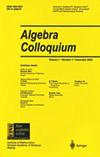酉群Un(2)的基本3-转置
IF 0.4
4区 数学
Q4 MATHEMATICS
引用次数: 0
摘要
我们的目的是研究简单酉群[公式:见文]上[公式:见文]的3-转置(横切)的极大对交换集,并从这些集构造设计。任何对交换3-转置的极大集称为转置的基本集。让[公式:见文本]。众所周知,[公式:见文]是一个3-转位群,集合[公式:见文]是由它的转位组成的共轭类,是3-转位集合。设[公式:见文本]为[公式:见文本]中的一组基本换位。我们给出了[公式:见文]和[公式:见文]-[公式:见文]设计[公式:见文],与[公式:见文]和[公式:见文]的一般描述。确定参数[公式:见文],[公式:见文]和[公式:见文]的进一步属性。作为例子,我们还将该方法应用于酉单群[公式:见文]、[公式:见文]、[公式:见文]、[公式:见文]、[公式:见文]和[公式:见文]。本文章由计算机程序翻译,如有差异,请以英文原文为准。
Basic 3-Transpositions of Unitary Group Un (2 )
We aim to study maximal pairwise commuting sets of 3-transpositions (transvections) of the simple unitary group [Formula: see text] over [Formula: see text], and to construct designs from these sets. Any maximal set of pairwise commuting 3-transpositions is called a basic set of transpositions. Let [Formula: see text]. It is well known that [Formula: see text] is a 3-transposition group with the set [Formula: see text], the conjugacy class consisting of its transvections, as the set of 3-transpositions. Let [Formula: see text] be a set of basic transpositions in [Formula: see text]. We give general descriptions of [Formula: see text] and [Formula: see text]- [Formula: see text] designs [Formula: see text], with [Formula: see text] and [Formula: see text]. The parameters [Formula: see text], [Formula: see text] and further properties of [Formula: see text] are determined. We also, as examples, apply the method to the unitary simple groups [Formula: see text], [Formula: see text], [Formula: see text], [Formula: see text], [Formula: see text] and [Formula: see text].
求助全文
通过发布文献求助,成功后即可免费获取论文全文。
去求助
来源期刊

Algebra Colloquium
数学-数学
CiteScore
0.60
自引率
0.00%
发文量
625
审稿时长
15.6 months
期刊介绍:
Algebra Colloquium is an international mathematical journal founded at the beginning of 1994. It is edited by the Academy of Mathematics & Systems Science, Chinese Academy of Sciences, jointly with Suzhou University, and published quarterly in English in every March, June, September and December. Algebra Colloquium carries original research articles of high level in the field of pure and applied algebra. Papers from related areas which have applications to algebra are also considered for publication. This journal aims to reflect the latest developments in algebra and promote international academic exchanges.
 求助内容:
求助内容: 应助结果提醒方式:
应助结果提醒方式:


